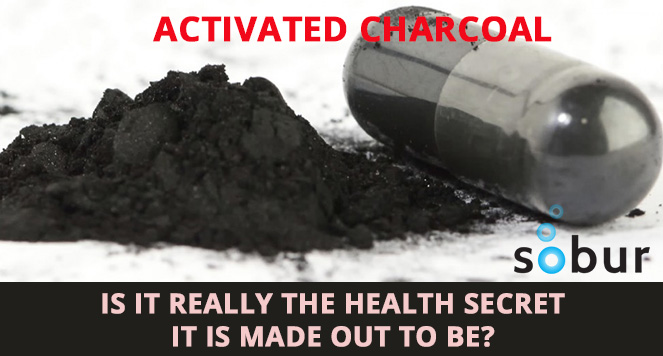
Today I learned (/r/TIL) that there was a strange suicidal trait in several 19th century professors and doctors, and a lot of it revolved around a highly absorbent gritty black material that has recorded uses in medical history for thousands of years; Activated Charcoal.
The first recorded uses of Activated Charcoal, also known as activated carbon, date back to the Egyptian Papyrus of 1550 BC Hippocrates, the western father of modern medicine, was reported to have his physicians treat epilepsy and anthrax with charcoal in 400 BC. In the 1700s charcoal was prescribed for excessive bile excretion problems. But it was around the 19th century that the ‘Activated Charcoal space’ got really interesting…
How Two Crazy French Professors Made The Public Aware of Activated Charcoal Benefits
First up, in 1813, was French chemist Michel Bertrand who swallowed an otherwise lethal dose of arsenic mixed with activated charcoal and survived. It was exactly 5gm of arsenic trioxide mixed with charcoal1 that Bertrand consumed, but other less fortunate scientists had difficulties confirming Bertrand’s findings over the following years, probably because the absorbing properties of the charcoal varied according to preparations2, and interest in the potentially life-saving Activated charcoal died down.
 In 1831 Professor Pierre-Fleurus Touéry, a pharmacist out of Montpellier France, decided to outdo Mr Bertrand and demonstrate the effectiveness of activated charcoal… again by putting his life at risk. Touéry’s demonstration, which was performed in front of the French Academy of Medicine (Academie Francaise) saw Touéry ingest a dose of strychnine, that was ten times higher than what was required to be a lethal dose3. To put that in context, Strychnine is rumoured to be the poison that killed Alexander the Great and its symptoms are said to be some of the most painful symptoms a person can experience by ingesting a toxic substance. In Alfred Hitchcock’s movie Psycho, the main character of the movie – Norman Bates – kills his mother and her lover with strychnine.
In 1831 Professor Pierre-Fleurus Touéry, a pharmacist out of Montpellier France, decided to outdo Mr Bertrand and demonstrate the effectiveness of activated charcoal… again by putting his life at risk. Touéry’s demonstration, which was performed in front of the French Academy of Medicine (Academie Francaise) saw Touéry ingest a dose of strychnine, that was ten times higher than what was required to be a lethal dose3. To put that in context, Strychnine is rumoured to be the poison that killed Alexander the Great and its symptoms are said to be some of the most painful symptoms a person can experience by ingesting a toxic substance. In Alfred Hitchcock’s movie Psycho, the main character of the movie – Norman Bates – kills his mother and her lover with strychnine.
Touéry took 15 grams of activated carbon along with his lethal dose of strychnine and stood in front of his audience as they all watched and waited in awe. They kept waiting, and waiting… yet nothing happened. Touéry’s shocked audience watched as the professor walked away from the event unharmed ~ proof enough for the medical community that activated charcoal benefits were real and worth researching further.
The braveness of these men is still evident in modern medicine, as many hospitals today still use activated charcoal for many types of poisoning and overdoses4.
How Does Activated Charcoal Work?
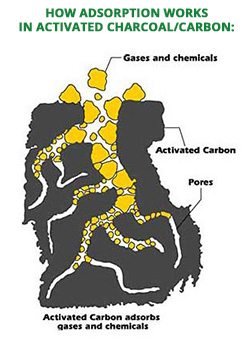 Over 4,000 chemicals, drugs, plant and microbial toxins, allergens, venoms, and wastes are effectively neutralised by activated charcoal5, at least when it is administered in sufficient quantities. Activated charcoal has this effect as it is a special form of carbon that can bind other substances on its surface (adsorption)6.
Over 4,000 chemicals, drugs, plant and microbial toxins, allergens, venoms, and wastes are effectively neutralised by activated charcoal5, at least when it is administered in sufficient quantities. Activated charcoal has this effect as it is a special form of carbon that can bind other substances on its surface (adsorption)6.
Adsorption is a process in which atoms and molecules move from a bulk phase (such as a solid, liquid, or gas) onto a solid or liquid surface7. As activated carbon (activated charcoal) is a crude form of graphite, the graphite structure gives it a very large surface area, which allows the carbon to adsorb a wide range of compounds. Activated charcoal actually has the strongest physical adsorption forces, or the highest volume of adsorbing porosity, of any material known to mankind8. For a little bit of context here, 3 grams of activated charcoal can have the surface area of a football field, or a 50 gram dose can have the surface area of 10 football fields9. This is due to activated charcoal’s surface area of 1000m²/g or greater.
If you’re really interested in the adsorption process, you have to understand London Dispersion Forces (yes, that is a real thing):
Adsorption is caused by London Dispersion Forces, a type of Van der Waals Force which exists between molecules. The force acts in a similar way to gravitational forces between planets.
London Dispersion Forces are extremely short ranged and therefore sensitive to the distance between the carbon surface and the adsorbate molecule. They are also additive, meaning the adsorption force is the sum of all interactions between all the atoms. The short range and additive nature of these forces results in activated carbon having the strongest physical adsorption forces of any material known to mankind.
“What is Adsorption?” – Chemviron Carbon
Why is it called ‘Activated’ Carbon or ‘Activated’ Charcoal?
The charcoal is “activated” because it is produced to have a very fine particle size. This increases the overall surface area and adsorptive capacity of the charcoal. The additional processing of the carbon to make it ‘activated’ is what separates it from regular charcoal briquettes like you might use in your outdoor grill.
What Is Activated Charcoal Made From?

Activated charcoal can be made from substances containing a high carbon content. Coal is considered to be the largest source for the manufacture of activated charcoals, but other sources include wood, sawdust/sawchip, coconut shells, bamboo, peat and petroleum coke. Other materials have been experimented with for activated charcoal production, but generally none are as cost-effective.
The raw material used has a very large influence on the characteristics and performance of the activated charcoal.
Historically charcoal has been made from wood, both softwoods and hardwoods. Charcoal’s first application (circa 1750 B.C.) was as a fuel for smelting ore. Charcoal burns hotter and cleaner than wood and so wood was converted to charcoal.
When Activated charcoal/carbon is derived from charcoal or coal, there are two basic activation processes:
- Charcoal is heated to very high temperatures (usually in the 600-1200 °C range) in the presence of oxidising gases such a CO2, steam, or air.
- Charcoal is impregnated with chemicals such as acids like phosphoric acid or bases like potassium hydroxide, or salts like zinc chloride, and then exposed to temperatures in the 450-900 °C range.
Chemical activation (option 2) is preferred over heat activation owing to the lower temperatures and shorter time needed for activating material. Both processes further erode the charcoal’s internal surfaces. This increases the adsorption capacity by creating an internal network of even smaller pores, rendering it two to three times as effective as regular charcoal10.
Making Your Own DIY Activated Charcoal
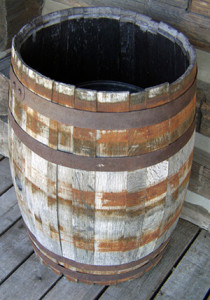 There are a number of Youtube videos that have popped up due to the growing popularity of activated charcoal for medicinal, filtration and other uses, but it should be noted that producing activated charcoal on a backyard scale would involve the use of several different dangerous chemicals; which does seem a little like a fatal accident waiting to happen.
There are a number of Youtube videos that have popped up due to the growing popularity of activated charcoal for medicinal, filtration and other uses, but it should be noted that producing activated charcoal on a backyard scale would involve the use of several different dangerous chemicals; which does seem a little like a fatal accident waiting to happen.
If you are considering making DIY chemically activated charcoal in your back garden with the intention of making a cheap water or air filter (both being popular uses of activated charcoal) then keep in mind that plain charcoal has a long history (3000+ years) of use in odour control and water purification!
Nasty fact: hospitals in the 1800s used plain charcoal powder to control the stench of rotting flesh. Ancient sea explorers scorched the inside of wooden water barrels to preserve drinking water during long voyages. The American Calvary used plain lump charcoal in the last compartment of a 3-compartment box (1. Gravel; 2. Washed sand; 3. Charcoal) to filter swamp water for drinking water11. Essentially, your regular charcoal will work effectively enough as both a water and air filter, without the potential mishaps that could come with playing the mad scientist and mixing potentially corrosive chemicals over a kitchen pan.
What Is Activated Charcoal Used For & What Are The Benefits?
As activated charcoal is incredibly porous and adsorbent (meaning that a wide range of molecules and chemicals stick to it) it is extremely beneficial/useful in all kinds of contexts; from water purification to gas masks to usage in clinical emergencies like overdoses or poisonings12.
Recently, activated charcoal has become a little bit of a ‘magic pill’ in several different industries & common-use cases. People have been discovering that activated charcoal has benefits that can help in the following areas:
1. Teeth Whitening
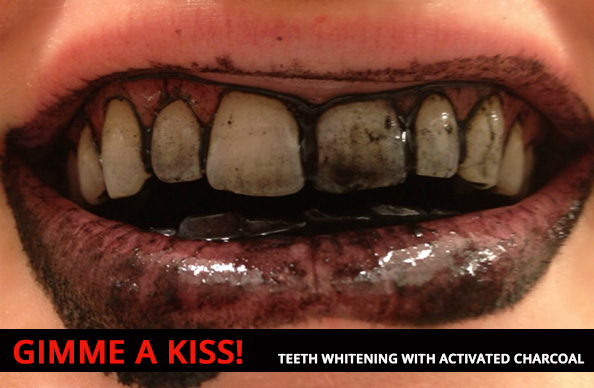
Activated charcoal for teeth whitening has become a beauty bloggers favourite new ‘secret routine’, alongside oil pulling using coconut oil (a traditional Ayurvedic remedy that has been used in India and Asia for 3,000 years to cleanse the body by detoxifying and cleaning teeth and gums13).
Why is activated charcoal so effective as a teeth whitening treatment that people are willing to brush their pearly whites with a scary looking black powder every morning? It’s because Activated charcoal LOVES tannins.
Tannins can be found in many foods like coffee, tea, wine, etc., and are typically what cause the staining and dinginess of the enamel of your teeth. While the activated carbon goes to work on adsorbing these tannins, it is also ‘tooth-friendly’ as it doesn’t adsorb the calcium salts that tooth enamel is made of14.
You used to be able to purchase tooth pastes that contained activated charcoal from store shelves (Lord Byron was famously recorded asking his friend Douglas Kinnaird to send him a supply of Lardner’s prepared charcoal for the teeth — a well known, at the time, toothpaste containing activated charcoal — while he was in Venice in 181815), but I’m guessing the scary black-toothed smile staring back at people while they were brushing their teeth turned the buying public off of the products.
If you are looking to use activated charcoal as a teeth whitening solution, it is recommended that you add a little (of the powdered form, or just split a capsule) to your tooth paste, or mix a little with water and swish around in your mouth for a few minutes after brushing. It is far less potentially irritating to your gums than hydrogen peroxide (another popular teeth whitening solution), and it’s not as tough on your mouth, in total.
2. Preventing Gas & Bloating

Unfortunately, the jury is still out on the effectiveness of activated charcoal when it comes to preventing gas/flatulence and stomach bloating (usually after food consumption). The studies on this exact topic are almost hypnotically regular:
- This study (1981) found that Activated Charcoal helped.
- This study (1985) found that it didn’t.
- This study (1986) found that it helped.
- This study (2000) found that it didn’t.
There is no solid answer, at least not yet. When it comes to gas and bloating, activated charcoal may or may not do anything. It’s unlikely to do you any harm (none of the studies reported worse symptoms after taking the charcoal), but it’s also quite likely to do nothing at all16.
3. Filtering Water
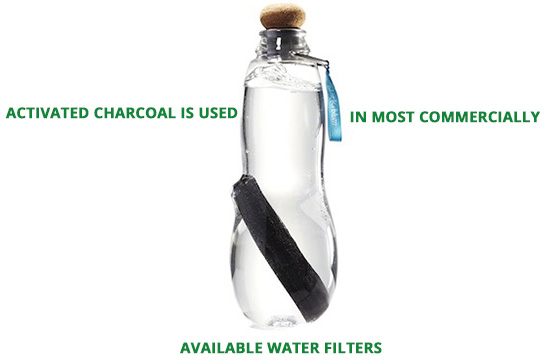
The superior adsorption qualities of activated charcoal make it a popular choice for water filters. These filters are typical in the homes of people who prefer the taste and health benefits of drinking pure, contaminant-free water. When the water passes through the charcoal filter, the impurities are caught in the charcoal’s deep pores, trapping them there until the filter is replaced17.
According to a study by Dr Ken Yaegaki and his team at the department of oral health within the Tokyo, Nippon Dental University; activated-carbon filters are effective in removing fluoride from drinking water18. Avoiding fluoride and detoxing from it is important for oral health, proper immune system functioning, and healthy kidneys and liver (fluoride is a cumulative poison that has been proven to cause wide-ranging, serious health problems, such as damage to your bones, brain and endocrine system.19)
As activated charcoal naturally bonds with toxins, it is used in almost every water filtration system in the world. In municipal water systems, various additives (chlorine, for example) are also included in the treatment of water20. And some municipal systems are not as rigorous as they could be, leading consumers to be wary of their common water source
It is possible to both purchase activated charcoal water filters or to make your own. Not only are homemade water filters inexpensive, but they can be a lifesaver when camping or if an emergency situation strikes. Just be sure to use the same high-quality granular charcoal that is used in a traditional water filter, so you can be confident that the water you’re drinking is safe.
Here’s a great PDF from the North Dakota State University that provides a good overview of your various DIY options for water filtration: “Filtration: Sediment, Activated Carbon and Mixed Media.”
4. Controlling Cholesterol Levels
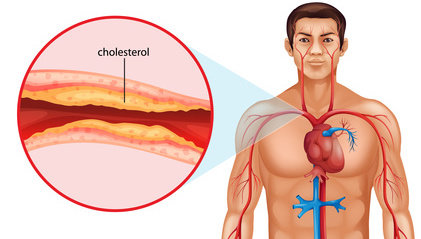
You can help your heart and circulatory system by taking Activated Charcoal. Activated Charcoal lowers the concentration of total lipids, cholesterol, and triglycerides in the blood serum, liver, heart and brain. In one study that was reported in the British journal Lancet on patients with high cholesterol, 8 gm. of Activated Charcoal taken three times a day lowered total cholesterol 25%, lowered LDL cholesterol 41% and doubled their HDL/LDL (high-density lipoprotein/low-density lipoprotein) cholesterol ratio. Microscopic tissue examination studies have shown that a daily dose of Activated Charcoal may prevent sclerotic changes in the heart and coronary blood vessels21.
There is, however, some contradictory research in the area of activated charcoal and its effect on cholesterol, making it far from conclusive that is as effective as we first thought. In a study entitled No effect of activated charcoal on hyperlipidaemia it was established (as you can guess from the title) that there was no effect of activated charcoal on cholesterol levels.
There is a lot more ‘pros’ than there are ‘cons’ in the Activated charcoal vs cholesterol levels debate, but it is very far from conclusive. If relying on activated charcoal as your primary method of cholesterol reduction, we advise researching the subject further and consulting a healthcare professional first.
5. Cleansing & Detoxing
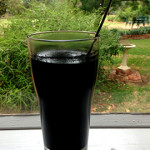 The first way that many people (particularly parents with young children) come across activated charcoal is when they are forced to search out a DIY or easily available detox agent, for cases of mild toxicity (for healing any discomfort, but not fatal injury, caused by swallowing too much of an over-the-counter drug, for example). Activated charcoal has a long history of use as a poison control drug, taken directly after poisoning as a form of damage control. As described, It works by adsorbing the drug in the digestive tract. Adsorption is not quite the same thing as Absorption, but it’s a similar process; the charcoal is essentially stealing all of the drug for itself, so your body doesn’t get any. For nutrients, this would be very bad, but for toxins, its great, because your body doesn’t want to get any of them.
The first way that many people (particularly parents with young children) come across activated charcoal is when they are forced to search out a DIY or easily available detox agent, for cases of mild toxicity (for healing any discomfort, but not fatal injury, caused by swallowing too much of an over-the-counter drug, for example). Activated charcoal has a long history of use as a poison control drug, taken directly after poisoning as a form of damage control. As described, It works by adsorbing the drug in the digestive tract. Adsorption is not quite the same thing as Absorption, but it’s a similar process; the charcoal is essentially stealing all of the drug for itself, so your body doesn’t get any. For nutrients, this would be very bad, but for toxins, its great, because your body doesn’t want to get any of them.
If you ever end up in the unfortunate situation where you’re in the hospital with an acute case of drug overdose, you might end up being administered with a dose of activated charcoal to help your body clear the poison/toxins. The typical example is people who take too many painkillers, for whatever reason. There has been some very in-depth reviews of the effectiveness of activated charcoal as a detoxing agent22, and there are some points to keep in mind:
- Activated charcoal is most effective as a detoxing tool within one hour of poisoning. It is not an all-purpose “detox” for accumulated toxins over a lifetime. It is instead a therapy for acute toxicity, the “my young child just swallowed a bunch of tylenol pills” type scenario. There is no evidence to support it’s effectiveness in other cases (not including occasions like Professor Pierre-Fleurus Touéry, mentioned earlier, who performed rudimentary experiments with activated charcoal and poisons and unscientifically put his own life at risk).
- Not all toxins are adsorbed to charcoal. It’s useful for some common prescription drugs, like acetaminophen (Tylenol), but it’s useless against iron, lithium and petroleum products.
6. Treating Alcohol Poisoning & Helping Prevent Hangovers
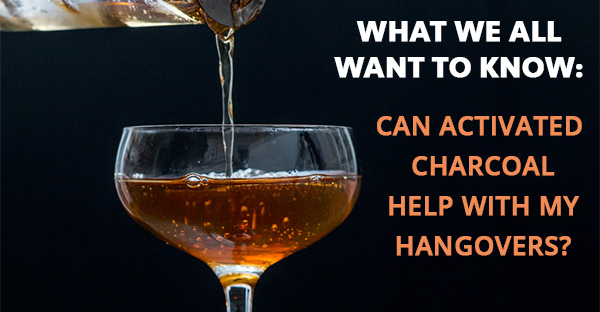
As you’re reading this on a blog all about answering the question “Can I cure my hangover? If so, how?” — it is no surprise that an obvious advantage to using activated charcoal in supplement or powder form is that it has (quite a significant) effect on how your body reacts to large quantities of alcohol. After all, according to the New Zealand Herald, charcoal pills and super shakes featuring the black grit are the hit new hangover cure!23
It’s supposed to work by binding to toxins in the digestive tract – effectively cleansing the body once it’s expelled in stool form.
Charcoal detox may cure that hangover
Does Alcohol Absorb to Activated Charcoal?
I find that this question is commonly asked by people who are really asking “Can activated charcoal be used for my hangover?” — which is a different question entirely.

Alcohol is not absorbed by activated charcoal, or, said in a different way, alcohol does not bind well to Activated Charcoal24. Ethanol is one of the few toxins that activated charcoal has been shown to have trouble adsorbing to its porous surface, and it would take a LOT of Activated Charcoal to absorb liquids that only bind modestly (liquids like ethanol/alcohol)25.
However, activated charcoal can have a significant positive effect when consumed following alcohol consumption, but not because alcohol/ethanol binds to it (it doesn’t, at least not very well, for several reasons) but because activated charcoal effectively prevents the gastrointestinal absorption of most drugs and toxins present in the stomach at the time of charcoal administration (except for alcohols, cyanide, and metals such as iron & lithium)26.
So activated charcoal, when taken at the same time as consuming alcohol,is helping to clear waste and a complete overload of toxins (which a solid night of drinking will happily provide) from the livers detox processes.
With that said you’re probably better sticking to a tried and tested fix for hangovers like dihydromyricetin, or our combination product, Sobur, which contains DHM, NAC, Vitamin C, B, and much more.
Activated charcoal also soothes the stomach, which gets irritated by high levels of alcohol, after drinking and prevents that sick feeling where you cant eat much for 12+ hours that usually accompanies hangovers.
The TL;DR answer to the ‘Can activated charcoal pills help with my alcohol hangover?’ question that I’m sure lead many of you to this article, is this: yes, activated charcoal can help with your hangover but not because alcohol absorbs to it, instead it’s because activated charcoal helps remove excess waste from the liver detox processes, which are running at full steam when overloaded with alcohol as it is. Additionally, activated charcoal helps soothe the stomach following alcohol consumption, as trouble eating and holding down food is a common hangover symptom.
Is activated charcoal safe?
There are some unwanted/unexpected side effects that can come with taking activated charcoal orally. While it is always worth consulting a medical professional if something seems off, the majority of these side-effects are small problems and activated charcoal, taken with the proper dosage, is considered very safe for consumption mostly because charcoal is neither digested nor absorbed in the gastro-intestinal tract.
Potential activated charcoal side effects
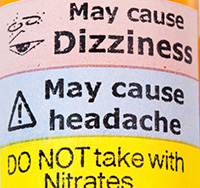 Black Stools
Black Stools
Activated charcoal will cause your stools to turn black. This is to be expected27, in fact it is good news because it tells you how long food takes to go through your bowel (called transit time).
Constipation
Try not to take activated charcoal alongside other prescription medications! Excessive charcoal consumption, especially without magnesium, can result in ‘block ups’ and constipation28.
Affects When Taken Alongside Other Medication
Activated charcoal is designed in such a way that it electrostatically attracts certain chemicals and micro-organisms (the adsorption process explained earlier). As a group, most compounds that are poisonous to the body are attracted to charcoal. Because most drugs are electro-chemically configured in a way similar to poisons and other toxic compounds, activated medicinal charcoal taken orally will often adsorb prescription medications and over-the-counter drugs29. This can be seen as a desirable effect if the goal is to counteract the effects of poisoning from overdosing on medications or if the goal is to detox/cleanse the accumulation of drugs in the body (common for recovering drug-addicts).
However, if there is any concern that activated charcoal will interfere with the desired effect of prescription or non-prescription drugs, it is recommended to take activated charcoal no closer than 1 to 1½ hours before or 1 to 1½ after taking drug medication. There is known potential adverse interactions with Activated Charcoal and the following drugs: 30
- Naltrexone (used for alcohol and opioid dependence)
- Acrivastine
- Bupropion
- Carbinoxamine
- Fentanyl
- Hydrocodone
- Meclizine
- Methadone
- Morphine
- Morphine Sulfate Liposome
- Mycophenolate Mofetil
- Mycophenolic Acid
- Oxycodone
- Oxymorphone
- Suvorexant
- Tapentadol
- Umeclidinium
- Acetaminophin
- Tricyclic antidepressants
- Theophylline
Overdose Risks
By its very nature, charcoal does not lend itself to overindulgence. Because charcoal is neither digested nor absorbed in the gastro-intestinal tract, there is therefore no concern of overdosing on activated charcoal. As noted above though, there are other uncomfortable side effects that too high a dosage can induce.
Can activated charcoal be taken during pregnancy?
Yes, so far as is known, activated charcoal is safe to be taken during pregnancy and lactation.
Sources:
- Erickson T. – Famous (And Not So Famous) Events In Toxicological History; Activated Charcoal: Universal Antidote or Black Magic. AACTion Volume 13, Number 2. by The American Academy of Clinical Toxicology. Accessed June 12, 2015. https://www.clintox.org/documents/newsletters/04_July_AACT_News.pdf ↩
- Ratzan, Richard M. “Who Goes First?: The Story of Self-Experimentation in Medicine By Lawrence K. Altman.” Perspectives in Biology and Medicine 43, no. 1 (1999). https://books.google.com/books?id=V1jwt-P8FjoC&lpg=PA96&ots=XCBRYa8m2_. ↩
- “Stopping Poison with Activated Carbon | Molecular Sieve Mavens.” Hengye. Accessed January 9, 2015. http://hengyeusa.com/community/stopping-poison-with-activated-carbon. ↩
- “Our Experience Using Activated Charcoal When We Had the ‘Stomach Bug’.” The Nourishing Gourmet. Accessed February 3, 2015. http://www.thenourishinggourmet.com/2014/01/using-activated-charcoal-to-prevent-and-treat-the-stomach-flu.html. ↩
- “Essential First Aid Item: Activated Carbon for Poison Emergencies – The Health Wyze Report.” The Health Wyze Report. Accessed February 9, 2015. http://healthwyze.org/reports/101-essential-first-aid-item-activated-carbon. ↩
- “Activated Charcoal – The bottom line.” Poison Control. Accessed February 11, 2015. http://www.poison.org/articles/2015-mar/activated-charcoal. ↩
- “Activated Charcoal Causes, Symptoms, Treatment – How Activated Charcoal Works.” EMedicineHealth. Accessed February 7, 2015. http://www.emedicinehealth.com/activated_charcoal/page2_em.htm. ↩
- “Activated Carbon Purification Systems – Chemviron Carbon.” Chemviron Carbon. Accessed February 19, 2015. http://www.chemvironcarbon.com/en/activated-carbon/what-is-activated-carbon. ↩
- “Activated Charcoal Causes, Symptoms, Treatment – How Activated Charcoal Works.” EMedicineHealth. Accessed February 7, 2015. http://www.emedicinehealth.com/activated_charcoal/page2_em.htm. ↩
- “What Is Activated Charcoal – Science & History.” BuyActivatedCharcoal.com. Accessed November 7, 2015. http://www.buyactivatedcharcoal.com/what_is_activated_charcoal. ↩
- “How to Make Activated Charcoal at Home.” BuyActivatedCharcoal.com. Accessed November 7, 2015. http://www.buyactivatedcharcoal.com/how_to_make_activated_charcoal. ↩
- “Charcoal Juice Is Now A Thing.” TIME.com. Accessed February 14, 2016. http://time.com/3678820/charcoal-juice-health-benefits/. ↩
- “Oil Pulling: Safe, Simple and Effective!” Earth Clinic – Holistic Health and Alternative Medicine. Accessed February 5, 2016. http://www.earthclinic.com/remedies/oil_pulling.html. ↩
- “Dazzle! Whiten Your Teeth With Activated Charcoal.” CrunchyBetty.com. Accessed February 2, 2016. http://www.crunchybetty.com/dazzle-whiten-your-teeth-with-activated-charcoal. ↩
- “Lardner’s Prepared Charcoal for the Teeth.” The Quack Doctor. Accessed February 2, 2016. http://thequackdoctor.com/index.php/lardners-prepared-charcoal-for-the-teeth/. ↩
- “All About Activated Charcoal | Paleo Leap.” Paleo Leap. Accessed February 3, 2016. http://paleoleap.com/activated-charcoal/. ↩
- “Activated Charcoal For Water Filters Removes Toxic Chemicals, Drugs, Bad Odors, and All Unwanted Taste.” BuyActivatedCharcoal.com. Accessed May 5, 2015. http://www.buyactivatedcharcoal.com/activated-charcoal-for-water-filters.html. ↩
- “Neither Hollow-Fibre Membrane Filters nor Activated-Charcoal Filters Remove Fluoride from Fluoridated Tap Water.” Canadian Dental Association. Last modified June 2008. http://www.cda-adc.ca/jcda/vol-74/issue-5/443.pdf. ↩
- “Fluoride is Found in Your Drinking Water.” Mercola.com. Accessed July 7, 2015. http://articles.mercola.com/sites/articles/archive/2013/01/20/fluoride-denialism.aspx. ↩
- “FAQS | Kishu Charcoal.” Kishu Charcoal. Accessed February 1, 2016. http://kishucharcoal.com/faqs/. ↩
- Dinsley, John. “7. Ancient and modern medicine.” In CharcoalRemedies.Com: The Complete Handbook of Medicinal Charcoal and Its Applications, 58-61. [Southside Boularderie, N.S.]: Gatekeeper Books, 2005. ↩
- “Position Statement: Single-Dose Activated Charcoal.” Journal of Toxicology: Clinical Toxicology 35, no. 7 (1997): 721-741. doi:10.3109/15563659709162569. http://www.ncbi.nlm.nih.gov/pubmed/9482427. ↩
- “Charcoal Detox May Cure That Hangover – Life & Style – NZ Herald News.” The New Zealand Herald. Accessed February 9, 2016. http://www.nzherald.co.nz/lifestyle/news/article.cfm?c_id=6&objectid=11588845. ↩
- Birch, Rebecca. “Activated Charcoal – time to get the coal story!” Kewo Science. Accessed February 7, 2016. http://www.kewo-science.com/activated-charcoal-time-to-get-the-coal-story/. ↩
- Rucker, Michael. “Activated Charcoal & Hangovers – Workplace Wellness | Digital Health.” MichaelRucker.com. Accessed February 10, 2016. http://michaelrucker.com/cure-hangovers/activated-charcoal/. ↩
- Neuvonen, Pertti J., and Klaus T. Olkkola. “Oral Activated Charcoal in the Treatment of Intoxications.” Medical Toxicology 3, no. 1 (1988): 33-58. doi:10.1007/bf03259930. <www.sobur.co/act-charcoal/neuvonen1988.pdf>. ↩
- “Charcoal, Activated (Oral Route) – National Library of Medicine.” PubMed Health. Accessed February 7, 2016. https://www.ncbi.nlm.nih.gov/pubmedhealth/PMH0045886/#DDIC602267.side_effects_section. ↩
- “Coconut Charcoal: The Best Activated Charcoal Detox.” BulletproofExec. Accessed February 1, 2016. https://www.bulletproofexec.com/the-strangest-way-to-detox/. ↩
- “Frequently Asked Questions About Medicinal Charcoal.” Charcoal Remedies. Accessed January 14, 2016. http://www.charcoalremedies.com/faq. ↩
- “Charcoal, Activated (Oral Route) Before Using – Mayo Clinic.” Mayo Clinic. Accessed February 6, 2016. http://www.mayoclinic.org/drugs-supplements/charcoal-activated-oral-route/before-using/drg-20070087. ↩

[…] actually makes Chaser Plus so effective is the inclusion of calcium carbonate and the activated carbon (listed among the “inactive ingredients”). The tiny ‘pores’ in the carbon […]
How interesting! I never knew there’s so much to make out of activated charcoal and amazing benefits from it.Thanks
So you’re saying activated charcoal would not be a good solution to ridding the body of toxins that have accumulated over a period of years, such as mercury from amalgam fillings or air pollution? Just curious. Do you have a suggestion as to what a good product for such a detox treatment?
Thank you!
( I have also forwarded my email add. hoping to take part in the alcohol detox trial. Hope to hear from you and hopeful your product works. It will sell like hotcakes!!! )
Interesting! there’s a lot of good benefits we can get with the charcoal, it can absorb dirt and also it can absorb scent, very nice!
Very good content to know the therapeutic benefits of activated charcoal. I am suffering skin pigmentation and for this reason, I am using activated charcoal drink recipes and it has superb action. My condition is improving and I want to use activated charcoal. Thanks for sharing this content.